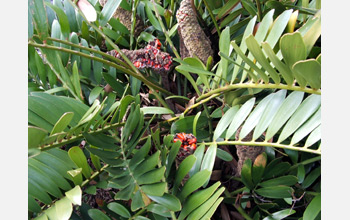All Images
News Release 10-235
What "Pine" Cones Reveal About the Evolution of Flowers
Research genetically traces flowers to a single common ancestor
This material is available primarily for archival purposes. Telephone numbers or other contact information may be out of date; please see current contact information at media contacts.

Close-up of a cycad with seed cones. Bright red seeds are erupting from the cones. Plant is tentatively identified as Zamia furfuracea. Cycads make seed-producing pine cone-like structures instead of flowers. Analysis shows Zamia's male cones have genetic wiring similar to flowers.
Credit: Randolph Femmer/life.nbii.gov
Download the high-resolution JPG version of the image. (2.5 MB)
Use your mouse to right-click (Mac users may need to Ctrl-click) the link above and choose the option that will save the file or target to your computer.

Based on recent RNA testing, biologists conclude a flower with genetic programming similar to a water lily may have been the very first flower.
Credit: © 2010 Jupiterimages Corporation

Persea americana (Avocado) flowers are said to essentially be "genetic fossils" still carrying genetic instructions that would have allowed the transformation of cones from non-flowering seed plants into flowers.
Credit: Andre Chanderbali, University of Florida
Download the high-resolution JPG version of the image. (81 KB)
Use your mouse to right-click (Mac users may need to Ctrl-click) the link above and choose the option that will save the file or target to your computer.

Researchers recently found a very significant degree of genetic overlap among intergrading floral organs in water lilies and avocado but less overlap in poppy and Arabidopsis, indicating the boundaries between floral organs are not all that sharp in the early angiosperm groups. This is the ABCE model of floral organ identity. Sepals are produced where A function acts alone, petals where A and B functions overlap, stamens where B and C functions combine, and carpels where C function acts alone.
Credit: Andre Chanderbali, University of Florida
Download the high-resolution JPG version of the image. (26 KB)
Use your mouse to right-click (Mac users may need to Ctrl-click) the link above and choose the option that will save the file or target to your computer.
